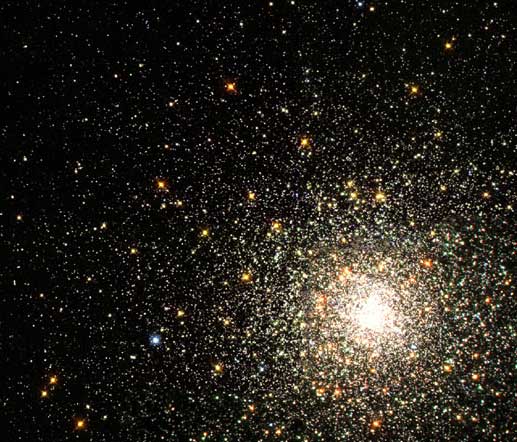
|
Credit & Copyright: F. R. Ferraro
(ESO
/Bologna Obs.),
M. Shara
(STSci
/AMNH) et al.,
& the Hubble Heritage Team (AURA/ STScI/ NASA)
Explanation:
If our Sun were part of M80, the
night sky would glow like a
jewel box of bright stars.
M80, also known as NGC 6093, is one of about 250
globular clusters that survive in our Galaxy.
Most of the stars in
M80 are older and redder than our
Sun,
but some enigmatic stars appear to be bluer and younger.
Young stars would contradict the hypothesis that
all the stars in
M80 formed at nearly the same time.
These unusual stars are known as
blue stragglers, and by analyzing pictures
like the
Hubble Space Telescope
image above, astronomers have been
able to find the largest population of
blue stragglers yet.
As
blue stragglers are now thought to be due to stars
coalescing, the collision and capture rate at the
dense center of M80 must be very high.
& the Hubble Heritage Team (AURA/ STScI/ NASA)
|
January February March April May June July August September October November December |
| ||||||||||||||||||||||||||||||||||||||||||||||||
NASA Web Site Statements, Warnings, and Disclaimers
NASA Official: Jay Norris. Specific rights apply.
A service of: LHEA at NASA / GSFC
& Michigan Tech. U.
Based on Astronomy Picture
Of the Day
Publications with keywords: globular cluster - cluster - M 8 - blue stragglers
Publications with words: globular cluster - cluster - M 8 - blue stragglers
See also:
- APOD: 2025 December 28 Á NGC 1898: Globular Cluster in the Large Magellanic Cloud
- APOD: 2025 November 26 Á Globular Cluster M15 Deep Field
- APOD: 2025 September 5 Á 47 Tucanae: Globular Star Cluster
- APOD: 2025 August 14 Á M13: The Great Globular Cluster in Hercules
- APOD: 2025 July 26 Á Globular Cluster Omega Centauri
- APOD: 2025 June 25 Á Rubin's First Look: A Sagittarius Skyscape
- NGC6366 vs 47 Ophiuchi
